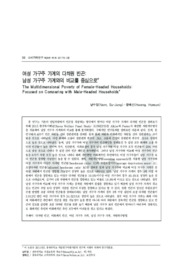

PARTNER
검증된 파트너 제휴사 자료
여성 가구주 가계의 다차원 빈곤: 남성 가구주 가계와의 비교를 중심으로 (The Multidimensional Poverty of Female-Headed Households: Focused on Comparing with Male-Headed Households)
17 페이지
최초등록일 2025.06.30
최종저작일
2017.02

-
미리보기
서지정보
· 발행기관 : 한국소비자학회
· 수록지 정보 : 소비자학연구 / 28권 / 1호 / 59 ~ 75페이지
· 저자명 : 남수정, 황혜선
초록
본 연구는 기존의 단일차원에서 빈곤을 측정하는 방식에서 벗어나 여성 가구주 가계의 다차원 빈곤을 살펴보기 위해 2015 한국복지패널(Korea Welfare Panel Study: KOWEPS)을 Alkire와 Foster가 제안한 차원계수방식을 적용하여 남성 가구주 가계와의 비교를 통해 분석하였다. 구체적인 연구결과를 살펴보면 다음과 같다. 첫째, 본 연구에서 6가지 빈곤 차원들 간의 상관관계를 살펴본 결과 화폐 차원과 비화폐적인 차원들 간의 상관관계는 크지 않은 것으로 나타났다. 다만 화폐와 고용의 상관관계 계수가 .344, 고용과 건강의 상관관계 계수가 .318로 상대적으로 높은 것으로 나타났다. 둘째, 남성 가구주와 여성 가구주의 빈곤패턴을 살펴보면 두 집단 모두 화폐와 고용 측면의 빈곤율이 높은 편이며 주거, 인간관계, 사회보장의 경우 남성 가구주와 여성 가구주 모두 빈곤율이 20% 미만으로 낮은 것으로 나타나 두 집단 간의 빈곤 패턴은 유사하였다. 그러나 남성 가구주와 비교해 여성 가구주의 빈곤율은 6가지 차원 모두 높은 것으로 나타나 화폐 측면뿐만 비화폐적인 측면에서도 여성 가구주들이 남성 가구주 보다 빈곤을 경험할 가능성이 높음 알 수 있었다. 셋째, 차원계수방법(counting approach)을 적용한 남성 가구주와 여성 가구주의 머릿수 다차원 빈곤율(headcount ratio: H)과 차원조정지수(average deprivation score: A), 조정다차원 빈곤율(adjusted headcount ratio: M)을 살펴본 결과 남성 가구주와 비교해 여성 가구주 가계가 중복된 차원에서 빈곤을 경험할 가능성이 상당히 높은 것으로 나타나고 있다. 남성 가구주 가계의 경우 3개 이상 차원에서 빈곤을 경험하고 있는 머릿수 다차원 빈곤율은 10.0%이지만 여성 가구주의 경우 40.4%로 상당히 높은 것으로 나타났으며, 심지어 4개 차원에서 빈곤을 경험하고 있는 비율도 18.8%에 이르고 있는 것으로 나타났다. 결국 남성 가구주와 비교해 여성 가구주 가계는 중복된 차원에서 결핍을 경험하고 있기 때문에 남성 가구주 가계가 겪고 있는 빈곤의 부담 보다 상당히 가중된 빈곤의 부담을 경험하고 있다고 할 수 있다. 또한 빈곤의 강도인 차원조정지수를 반영한 조정 다차원 빈곤율을 살펴보더라도 남성 가구주 가계의 경우 3개 이상 집단의 조정 다차원 빈곤율이 3.012인 반면 여성 가구주의 경우 24.523으로 상당히 높은 것으로 나타났다. 결국 여성 가구주 가계는 화폐 이외에 비화폐적인 측면에서 빈곤을 겪을 가능성이 높을 뿐만 아니라 여러 차원에서 중복적인 빈곤을 경험하고 있고 빈곤의 강도를 감안한 조정 다차원 빈곤율 또한 높기 때문에 남성 가구주 보다 빈곤에서 벗어나기 어려우며 상대적으로 화폐적인 측면과 비화폐적인 측면 모두에서 어려움을 겪고 있다고 하겠다.영어초록
The purpose of this study was to compare multidimensional poverty of female-headed households to that of male-headed households based on the counting approach which was theorized by Alkire and Foster to overcome the problems of unidimensional approach, union method and intersection method to address the multidimensional poverty. By applying the counting approach to 2015 Korea Welfare Panel Study, the headcount ratio, average deprivation score and adjusted headcount ratio were measured to identify multidimensional poverty.
First, the correlations between dimensions were statistically significant. The result showed that the correlations between monetary dimension and non-monetary dimension were relatively low. Correlation coefficient between money and employment was .344; correlation between employment and social security was .296; correlation between money and health .230. In addition, with regard to correlations between money and other dimensions were .108 for housing, .093 for human relations, and .145 for social security, which showed correlations between monetary dimension and non-monetary dimensions were relatively low.
Second, female-headed households showed similar poverty pattern to male-headed households. The poverty rates of money and employment were high for both groups of male-headed and female-headed household. On the other hand, the poverty rates of housing, human relations and social security were relatively low; the rates of these dimensions were lower than 20%. However, the poverty rates of all dimensions were higher for the group of female-headed households than male-headed households, which shows that female-headed households are more likely to have experience of poverty.
Third, according to the headcount ratio (H), the average deprivation score (A), the adjusted headcount ratio (M) based on the counting approach, female-headed households were more likely to experience multidimensional poverty than male-headed households. The headcount ratio of male-headed households with experience of three or more poverty dimensions were 10.0%; the ratio of female-headed households with three or more dimensions of poverty were 40.4%. This result shows that female-headed households are more likely to have experience of multidimensional poverty, which aggravates female-headed household’s poverty experience. When comparing female- and male-headed households’ adjusted headcount ratio, female-headed households’ ratio was 24.523 which is much higher than male-headed households’ ratio, 3.012. As a result, female-headed households are more likely to experience not only monetary poverty but also non-monetary poverty with multidimensional poverty experience than male-headed households. Moreover, female-headed households’ adjusted headcount ratio which reflects the intensity of poverty based on the average deprivation score was much higher than male-headed households, which shows female-headed households may experience more difficulties in overcoming poverty than male-headed households.참고자료
· 없음태그
-
자주묻는질문의 답변을 확인해 주세요

꼭 알아주세요
-
자료의 정보 및 내용의 진실성에 대하여 해피캠퍼스는 보증하지 않으며, 해당 정보 및 게시물 저작권과 기타 법적 책임은 자료 등록자에게 있습니다.
자료 및 게시물 내용의 불법적 이용, 무단 전재∙배포는 금지되어 있습니다.
저작권침해, 명예훼손 등 분쟁 요소 발견 시 고객센터의 저작권침해 신고센터를 이용해 주시기 바랍니다. -
해피캠퍼스는 구매자와 판매자 모두가 만족하는 서비스가 되도록 노력하고 있으며, 아래의 4가지 자료환불 조건을 꼭 확인해주시기 바랍니다.
파일오류 중복자료 저작권 없음 설명과 실제 내용 불일치 파일의 다운로드가 제대로 되지 않거나 파일형식에 맞는 프로그램으로 정상 작동하지 않는 경우 다른 자료와 70% 이상 내용이 일치하는 경우 (중복임을 확인할 수 있는 근거 필요함) 인터넷의 다른 사이트, 연구기관, 학교, 서적 등의 자료를 도용한 경우 자료의 설명과 실제 자료의 내용이 일치하지 않는 경우
문서 초안을 생성해주는 EasyAI
